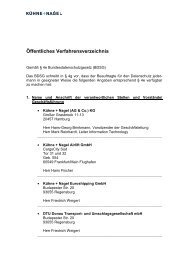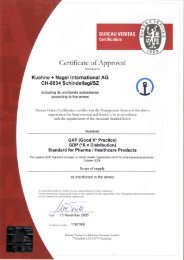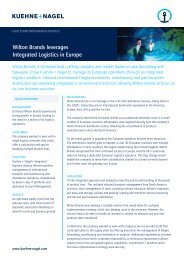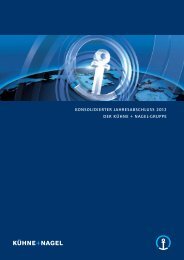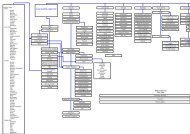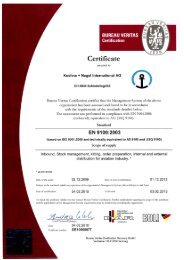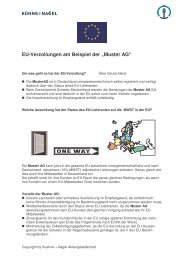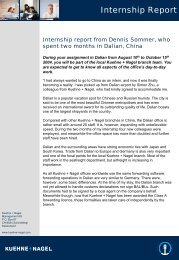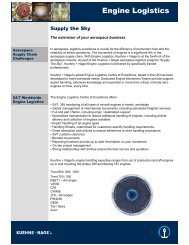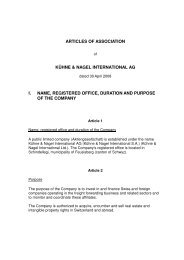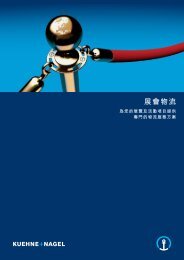ANNUAL REPORT 2011 - Kuehne + Nagel
ANNUAL REPORT 2011 - Kuehne + Nagel
ANNUAL REPORT 2011 - Kuehne + Nagel
Create successful ePaper yourself
Turn your PDF publications into a flip-book with our unique Google optimized e-Paper software.
The more significant changes in the scope of consolidation for<br />
the year 2010 are related to the following companies:<br />
5 Principles of consolidation<br />
Business combinations<br />
Business combinations are accounted for by applying the acquisition<br />
method. The Group measures goodwill as the fair value of<br />
the consideration transferred (including the fair value of any previously<br />
held equity interest in the acquiree) and the recognised<br />
amount of any non-controlling interests in the acquiree, less the<br />
net recognised amount (generally fair value) of the identifiable<br />
assets acquired and liabilities assumed, all measured as of the<br />
acquisition date. When the excess is negative, a bargain purchase<br />
gain is recognised immediately in profit or loss.<br />
The Group elects on a transaction-by-transaction basis whether<br />
to measure non-controlling interest at its fair value or at its proportionate<br />
share of the recognised amount of the identifiable<br />
net assets, at the acquisition date.<br />
Consideration transferred includes the fair values of the assets<br />
transferred, liabilities incurred by the Group to the previous owners<br />
of the acquiree, equity interests issued by the Group and the<br />
fair value of any contingent consideration. If the contingent consideration<br />
is classified as equity, it is not re-measured, and settlement<br />
is accounted for within equity. Otherwise, subsequent<br />
changes to the fair value of the contingent consideration are<br />
recognised in profit or loss. The consideration transferred does not<br />
include amounts related to the settlement of pre-existing relationships.<br />
Such amounts are generally recognised in profit or loss.<br />
Consolidated Financial Statements <strong>2011</strong> _ _ _ _ _ _ Accounting Policies<br />
Capital share 1 Currency Share capital Acquisition/<br />
acquired in per cent in 1,000 incorporation date<br />
equals voting rights<br />
Acquisition<br />
Nacora Insurance Brokers Ltd., Taiwan 2 30 TWD 6,000 June 18, 2010<br />
Incorporation<br />
<strong>Kuehne</strong> + <strong>Nagel</strong> Management ME FZE,<br />
United Arab Emirates 100 AED 1,000 January 1, 2010<br />
Stute Stahlservice GmbH, Germany 100 EUR 25 February 1, 2010<br />
<strong>Kuehne</strong> + <strong>Nagel</strong> Management S.A., Panama 100 USD 10 December 1, 2010<br />
1 For the capital share as per December 31, 2010, please refer to the list of the Group’s significant subsidiaries and joint ventures on pages 114 to 119.<br />
2 The Group previously owned 70 per cent of share capital and applied the full consolidation method. The main activity is Insurance Brokers.<br />
There were no significant divestments in the year 2010.<br />
Transaction costs, other than those associated with the issue of<br />
debt or equity securities, incurred in connection with a business<br />
combination are expensed as incurred.<br />
Written put options held by non-controlling shareholders<br />
When the Group has a potential obligation to purchase shares<br />
in a subsidiary from a non-controlling shareholder through a<br />
written put option, a liability is recognised at fair value, against<br />
equity. When a non-controlling shareholder still has present<br />
access to the economic benefits associated with the underlying<br />
ownership interest, the non-controlling interest in the subsidiary<br />
continues to be recognised as a separate component in equity.<br />
The liability is re-estimated at each reporting date. Any subsequent<br />
changes in the liability’s carrying amount are recognised<br />
in profit or loss.<br />
Acquisitions and disposals of non-controlling interests<br />
Changes in the parent’s ownership interest in a subsidiary after<br />
having obtained control that do not result in a loss of control<br />
are accounted for as transactions with owners in their capacity<br />
as owners, and the effect of such transactions is recognised in<br />
equity. No goodwill is recognised as a result of acquisition of<br />
non-controlling interests, and no gain or loss on disposals of<br />
non-controlling interests is recognised in profit or loss. The<br />
adjustments to non-controlling interests are based on a proportionate<br />
amount of the net assets of the subsidiary.<br />
63





